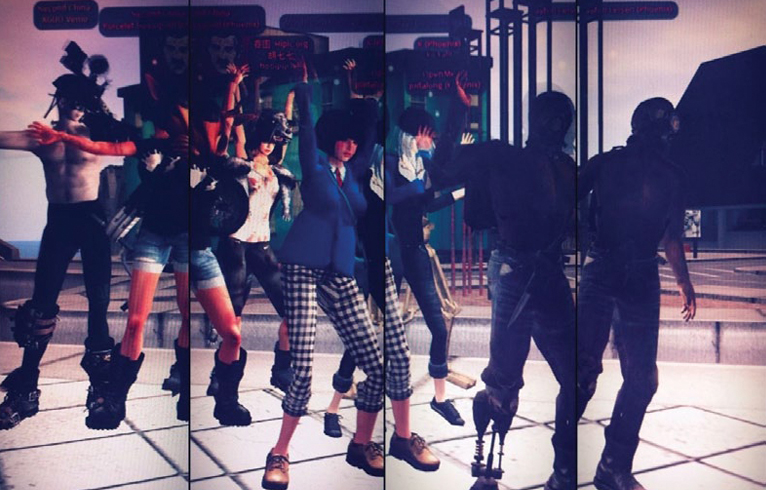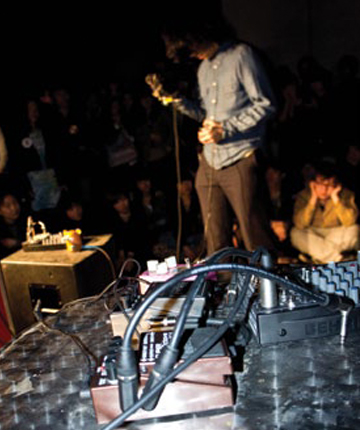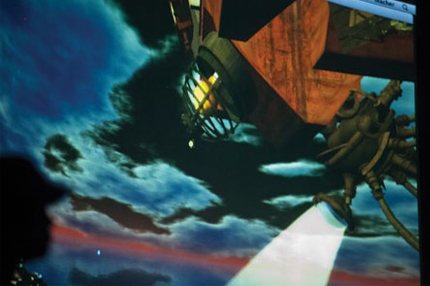MEDIA SOCIAL: SONART & OPEN MEDIA LAB
| June 27, 2011 | Post In LEAP 9

SONART
First of all, the idea of SONART is not at all limited to sound art or experimental music performance. The concept of a series of cutting-edge live performances and audio-visual publications was proposed by Gao Shiming, Executive Director of School of Intermedia Art, and I am the one responsible for its realization. SONART stands for an integration of the ideas of “Sonar” and “art,” sending out artworks as pulses and waiting for reflected echoes. It is social testing and surveying mediated through art, a completion of the art ecosystem through social feedback. Sites and spaces for SONART events are totally flexible. Future instantiations will not be limited to our first event site. SONART could be outdoors on the grass, beside the lake, in different cities and countries; for example, the art group MadeIn Company has invited us to produce an event in Shanghai. Furthermore, some future live events will take place and exist only on the Internet, on such platforms as Sina Weibo, Twitter, Second Life, and next-generation modes of existence. The other important area of the SONART project is publication. We will be releasing different series of new media works online, on paper, on DVD, CD, and in the Apple App Store.
The first SONART live event shared the same demanding standards in quality of works and production with the large-scale international new media festivals I have curated in the past, festivals including Sounding Beijing (2003), Sounding Taipei (2004), and the 2008 Shanghai eArts Festival opening performances “Streaming Objects.” SONART 4.1 in Hangzhou included several important works. First, a unique presentation crossing over the boundary between virtual and real-life by SLG+Second Life Group, led by world-renowned Second Life artist Shen Ligong. This work is a combined interactive effort involving dozens of artists and participants, both at the performance venue and in Second Life. The interactive 3D audio-visual objects in Second Life were built, rendered, and coded by members of the group and operated by them in real-time on ten computers, with the audio-visual results projected and broadcast at the performance site, while artists and audiences in other countries interacted with the virtual construction in Second Life via direct avatar manipulation and online chatting. The work climaxed with a dance by a group of avatars controlled by operators distributed all over the real world. This was the result of over a month of round-the-clock hard work directed by Shen Ligong.

The highly self-reflexive sound/body performance by Jiang Zhuyun (Jimu) was an homage to the well-known U.S. sound artist Randy Yau. Yau’s controversial yet well-received live noise performance in which he swallowed a pile of fresh celery until he vomited, creating a wonderful sight and sound outburst, was taken by Jiang as a “notated piece,” in the classical-music sense of the word, and reinterpreted as closely to the original as he possibly could. This non-traditional act (in experimental sound art practice) and the similarities and dissimilarities between the two happenings, whether visual, contextual, technical, or aural, make us wonder: Is extreme sound performance, now entering a highly “self-reflexive period” that also signals the end of its glorious era? Is Jiang’s work also a self-conscious, self-mocking stab at the true nature of the “rip-off” period we are situated in, here and now, on an abstract level?
Wang Zhipeng is a representative figure in the new generation of artists that literally think and work simultaneously, in visuals and sound. A sophomore student at Open Media Lab, Wang had taken only four weeks of classes in electronic music programming using Max/MSP, and yet, his show at SONART 4.1 rendered the audience speechless, for its technical complexity and power approached those of the masters of the trade such as Ryoji Ikeda and Frank Bretschneider. Wang is one of the few that can be called the young blood in audio-visual media performance in China. His is a direction that presents no role models in sight. In which direction will this generation of new Chinese digital artists evolve? We are anxiously watching.
It is understandable that many will mistake SONART for a sound art event. While it covers many more types of live art, it also includes certain categories of live sound art and experimental music. For we believe the format of live sound or music performance, which offers an opportunity of synchronic ritual for both the artist and the audience in close physical proximity and even with eye contact, may present a key inspiration to current digital media art in this country, which is becoming more and more inhuman and lacking in excitement. SONART can be social, laudatory, emotional, sensational, repulsive, critical. I call it “media social.”
OPEN MEDIA LAB
Open Media Lab, under the direction of Shen Ligong, presents an important “opening” in the existing organizational structure at the China Academy of Art. It is completely open in attitude, and interdisciplinary in technique. It can embody any type of new carrier or concept of art, and, more importantly, it is future-oriented, with an insistence on the “fun factor.”
Currently, Open Media Lab is focused on social media, Second Life, algorithmic art, and hand-held device applications. Our output will be delivered cross-platform, ranging from the net, Twitter and its local rip-offs to the iTunes Store, App Store, and all types of physical spaces. The key is, we will not be limited to or dominated by art spaces, or the contemporary art machine that operates behind the art spaces.
For example, right after the founding of Open Media Lab, Shen Ligong and I offered a course called “Social Media Art Live,” which resulted in the creation of the first batch of social media artworks and the first social media art exhibition in this country. Among them are Li Shun’s Microblog Analects, which is a book of Sina Weibo “tweets” in traditional Chinese binding; Zheng Jing’s live performance dealing with micro-blogging identity schizophrenia; and the interactive street/Twitter performance work by the “Social Enzymedia Unit.” In general, we are not interested in the concept of “social” as defined mostly by geographic positioning.

I have also founded a hand-held device performance group, “Soul Lemon.” The name is derived from the Cantonese pronunciation of “Handmade Noodles.” We created an audio-visual performance at the Rockbund Art Museum in Shanghai by improvising entirely on hand-held devices such as iPhones and iPads. However, unlike other similar acts, we refrained from using any apps made for music or visual purposes and restricted ourselves to your everyday utility or game apps, yet created a show that can stand on its audiovisual output and not technical gimmickry. During the second half of the show, we opened up our entire gear setup to the audience and let them play with it. These are in fact concrete metaphors of the social media concepts of Web 2.0 and user-generated content. Currently, I’m teaching a course in programming and iPhone application development. This is a new domain for us. Once opened up, this direction will lead to more lively works and wider platforms. We can deliver on Windows, iOS, iPhone, Android and other systems.
Open Media Lab is not interested in the traditional art space ecosystem, the star system and the power hierarchy of the last century. For instance, I think it is a serious case of anachronism to discuss “sound art” in gallery spaces using worn-out theoretical jargon. For the site of sound art practice/theory is omnipresent, in everyone’s hands, and certainly not in visual art spaces. As an example, the craze of cheap, plastic (Chinese-made) vuvuzelas triggered by the South African World Cup is the concretization of what I see as “noise 2.0” in the post-Attali sense. And, the latest social media platform of TalkBox available on iPhone and Android is, in all actuality, “sound art 2.0”— it is sound, and it is art, for and by the people.
As for “social media art,” Open Media Lab does not believe in the still prevalent modus operandi of taking French theories and applying them to work done within the biennale construct. Today, the true “social media art” is the entirety of the contents that is being created and updated on social media platforms every second by everyone on his/her handheld device. On a deeper level, the art and non-art works merely taking advantage of social media platforms such as Twitter and micro-blogging are not the most groundbreaking or paradigmatic. Social media system structures such as Twitter, micro-blogging, and TalkBox are themselves, as platforms and carriers, the most powerful social media art now.


